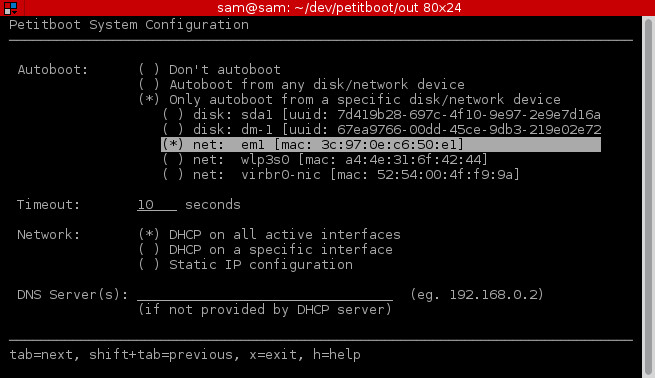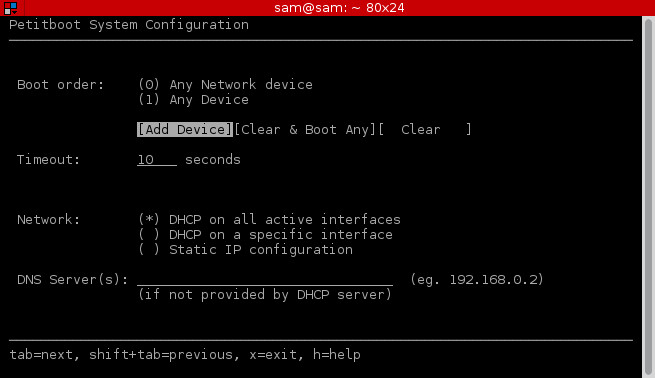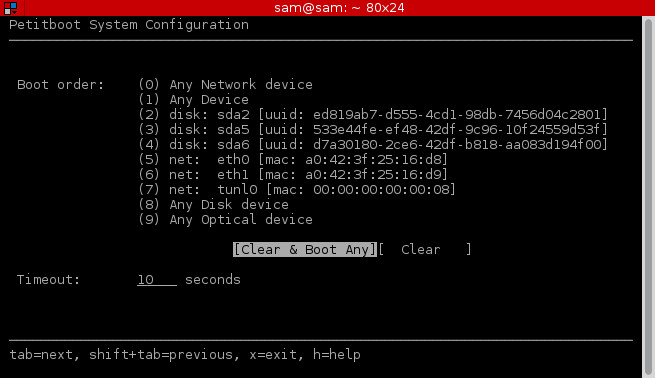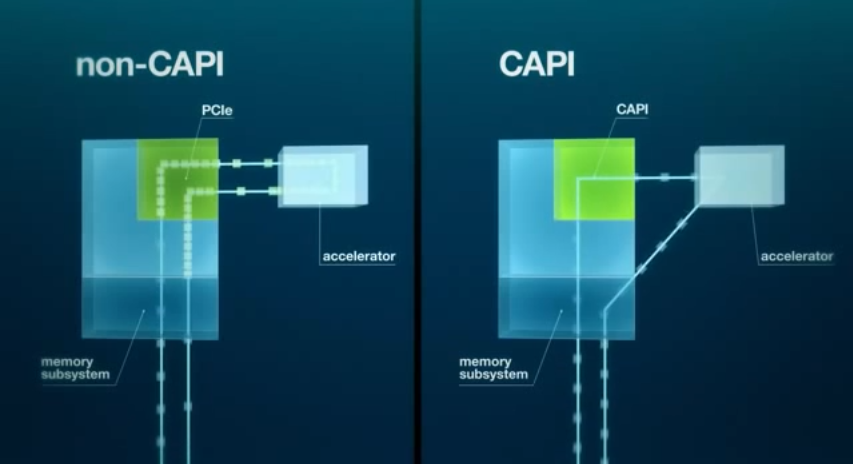So today I saw Freestanding “Hello World” for OpenPower on Hacker News. Sadly Andrei hadn't been able to test it on real hardware, so I set out to get it running on a real OpenPOWER box. Here's what I did.
Firstly, clone the repo, and, as mentioned in the README, comment out mambo_write. Build it.
Grab op-build, and build a Habanero defconfig. To save yourself a fair bit of time, first edit openpower/configs/habanero_defconfig to answer n about a custom kernel source. That'll save you hours of waiting for git.
This will build you a PNOR that will boot a linux kernel with Petitboot. This is almost what you want: you need Skiboot, Hostboot and a bunch of the POWER specific bits and bobs, but you don't actually want the Linux boot kernel.
Then, based on op-build/openpower/package/openpower-pnor/openpower-pnor.mk, we look through the output of op-build for a create_pnor_image.pl command, something like this monstrosity:
PATH="/scratch/dja/public/op-build/output/host/bin:/scratch/dja/public/op-build/output/host/sbin:/scratch/dja/public/op-build/output/host/usr/bin:/scratch/dja/public/op-build/output/host/usr/sbin:/home/dja/bin:/home/dja/bin:/home/dja/bin:/usr/local/bin:/usr/bin:/bin:/usr/local/games:/usr/games:/opt/openpower/common/x86_64/bin" /scratch/dja/public/op-build/output/build/openpower-pnor-ed1682e10526ebd85825427fbf397361bb0e34aa/create_pnor_image.pl -xml_layout_file /scratch/dja/public/op-build/output/build/openpower-pnor-ed1682e10526ebd85825427fbf397361bb0e34aa/"defaultPnorLayoutWithGoldenSide.xml" -pnor_filename /scratch/dja/public/op-build/output/host/usr/powerpc64-buildroot-linux-gnu/sysroot/pnor/"habanero.pnor" -hb_image_dir /scratch/dja/public/op-build/output/host/usr/powerpc64-buildroot-linux-gnu/sysroot/hostboot_build_images/ -scratch_dir /scratch/dja/public/op-build/output/host/usr/powerpc64-buildroot-linux-gnu/sysroot/openpower_pnor_scratch/ -outdir /scratch/dja/public/op-build/output/host/usr/powerpc64-buildroot-linux-gnu/sysroot/pnor/ -payload /scratch/dja/public/op-build/output/images/"skiboot.lid" -bootkernel /scratch/dja/public/op-build/output/images/zImage.epapr -sbe_binary_filename "venice_sbe.img.ecc" -sbec_binary_filename "centaur_sbec_pad.img.ecc" -wink_binary_filename "p8.ref_image.hdr.bin.ecc" -occ_binary_filename /scratch/dja/public/op-build/output/host/usr/powerpc64-buildroot-linux-gnu/sysroot/occ/"occ.bin" -targeting_binary_filename "HABANERO_HB.targeting.bin.ecc" -openpower_version_filename /scratch/dja/public/op-build/output/host/usr/powerpc64-buildroot-linux-gnu/sysroot/openpower_version/openpower-pnor.version.txt
Replace the -bootkernel arguement with the path to ppc64le_hello, e.g.: -bootkernel /scratch/dja/public/ppc64le_hello/ppc64le_hello
Don't forget to move it into place!
mv output/host/usr/powerpc64-buildroot-linux-gnu/sysroot/pnor/habanero.pnor output/images/habanero.pnor
Then we can use skiboot's boot test script (written by Cyril and me, coincidentally!) to flash it.
ppc64le_hello/skiboot/external/boot-tests/boot_test.sh -vp -t hab2-bmc -P <path to>/habanero.pnor
It's not going to get into Petitboot, so just interrupt it after it powers up the box and connect with IPMI. It boots, kinda:
[11012941323,5] INIT: Starting kernel at 0x20010000, fdt at 0x3044db68 (size 0x11cc3)
Hello OPAL!
_start = 0x20010000
_bss = 0x20017E28
_stack = 0x20018000
_end = 0x2001A000
KPCR = 0x20017E50
OPAL = 0x30000000
FDT = 0x3044DB68
CPU0 not found?
Pick your poison:
Choices: (MMU = disabled):
(d) 5s delay
(e) test exception
(n) test nested exception
(f) dump FDT
(M) enable MMU
(m) disable MMU
(t) test MMU
(u) test non-priviledged code
(I) enable ints
(i) disable ints
(H) enable HV dec
(h) disable HV dec
(q) poweroff
1.42486|ERRL|Dumping errors reported prior to registration
Yes, it does wrap horribly. However, the big issue here (which you'll have to scroll to see!) is the "CPU0 not found?". Fortunately, we can fix this with a little patch to cpu_init in main.c to test for a PowerPC POWER8:
cpu0_node = fdt_path_offset(fdt, "/cpus/cpu@0");
if (cpu0_node < 0) {
cpu0_node = fdt_path_offset(fdt, "/cpus/PowerPC,POWER8@20");
}
if (cpu0_node < 0) {
printk("CPU0 not found?\n");
return;
}
This is definitely the wrong way to do this, but it works for now.
Now, correcting for weird wrapping, we get:
Hello OPAL!
_start = 0x20010000
_bss = 0x20017E28
_stack = 0x20018000
_end = 0x2001A000
KPCR = 0x20017E50
OPAL = 0x30000000
FDT = 0x3044DB68
Assuming default SLB size
SLB size = 0x20
TB freq = 512000000
[13205442015,3] OPAL: Trying a CPU re-init with flags: 0x2
Unrecoverable exception stack top @ 0x20019EC8
HTAB (2048 ptegs, mask 0x7FF, size 0x40000) @ 0x20040000
SLB entries:
1: E 0x8000000 V 0x4000000000000400
EA 0x20040000 -> hash 0x20040 -> pteg 0x200 = RA 0x20040000
EA 0x20041000 -> hash 0x20041 -> pteg 0x208 = RA 0x20041000
EA 0x20042000 -> hash 0x20042 -> pteg 0x210 = RA 0x20042000
EA 0x20043000 -> hash 0x20043 -> pteg 0x218 = RA 0x20043000
EA 0x20044000 -> hash 0x20044 -> pteg 0x220 = RA 0x20044000
EA 0x20045000 -> hash 0x20045 -> pteg 0x228 = RA 0x20045000
EA 0x20046000 -> hash 0x20046 -> pteg 0x230 = RA 0x20046000
EA 0x20047000 -> hash 0x20047 -> pteg 0x238 = RA 0x20047000
EA 0x20048000 -> hash 0x20048 -> pteg 0x240 = RA 0x20048000
...
The weird wrapping seems to be caused by NULLs getting printed to OPAL, but I haven't traced what causes that.
Anyway, now it largely works! Here's a transcript of some things it can do on real hardware.
Choices: (MMU = disabled):
(d) 5s delay
(e) test exception
(n) test nested exception
(f) dump FDT
(M) enable MMU
(m) disable MMU
(t) test MMU
(u) test non-priviledged code
(I) enable ints
(i) disable ints
(H) enable HV dec
(h) disable HV dec
(q) poweroff
<press e>
Testing exception handling...
sc(feed) => 0xFEEDFACE
Choices: (MMU = disabled):
(d) 5s delay
(e) test exception
(n) test nested exception
(f) dump FDT
(M) enable MMU
(m) disable MMU
(t) test MMU
(u) test non-priviledged code
(I) enable ints
(i) disable ints
(H) enable HV dec
(h) disable HV dec
(q) poweroff
<press t>
EA 0xFFFFFFF000 -> hash 0xFFFFFFF -> pteg 0x3FF8 = RA 0x20010000
mapped 0xFFFFFFF000 to 0x20010000 correctly
EA 0xFFFFFFF000 -> hash 0xFFFFFFF -> pteg 0x3FF8 = unmap
EA 0xFFFFFFF000 -> hash 0xFFFFFFF -> pteg 0x3FF8 = RA 0x20011000
mapped 0xFFFFFFF000 to 0x20011000 incorrectly
EA 0xFFFFFFF000 -> hash 0xFFFFFFF -> pteg 0x3FF8 = unmap
Choices: (MMU = disabled):
(d) 5s delay
(e) test exception
(n) test nested exception
(f) dump FDT
(M) enable MMU
(m) disable MMU
(t) test MMU
(u) test non-priviledged code
(I) enable ints
(i) disable ints
(H) enable HV dec
(h) disable HV dec
(q) poweroff
<press u>
EA 0xFFFFFFF000 -> hash 0xFFFFFFF -> pteg 0x3FF8 = RA 0x20080000
returning to user code
returning to kernel code
EA 0xFFFFFFF000 -> hash 0xFFFFFFF -> pteg 0x3FF8 = unmap
I also tested the other functions and they all seem to work. Running non-priviledged code with the MMU on works. Dumping the FDT and the 5s delay both worked, although they tend to stress IPMI a lot. The delay seems to correspond well with real time as well.
It does tend to error out and reboot quite often, usually on the menu screen, for reasons that are not clear to me. It usually starts with something entirely uninformative from Hostboot, like this:
1.41801|ERRL|Dumping errors reported prior to registration
2.89873|Ignoring boot flags, incorrect version 0x0
That may be easy to fix, but again I haven't had time to trace it.
All in all, it's very exciting to see something come out of the simulator and in to real hardware. Hopefully with the proliferation of OpenPOWER hardware, prices will fall and these sorts of systems will become increasingly accessible to people with cool low level projects like this!





